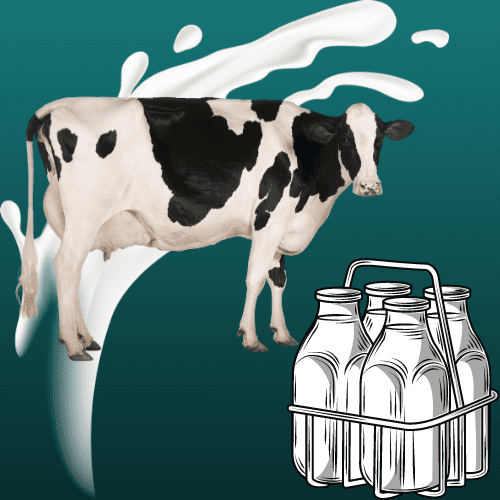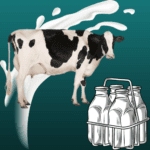
Cow’s milk is designed for baby calves – calves that double in size in 45 days compared to 108 days it takes a human baby to double in size. Whale’s milk is 34% fat, suitable for baby whales.
According to Alyssa Hamilton author of Got Milked, “Human milk on one hand is high in polyunsaturated fats such as linoleic acid, which are critical for brain development. Cows milk on the other hand is lower in these fatty acids and high saturated fats and proteins both of which are good for rapid weight gain. Humans need more and less. We need more of the brain-building essentials and less of the body-building baggage.” This is likely why about 70% of humans globally don’t digest milk well after infancy.
In recent decades the weight gain from sodas and sugary sports drinks has been in the spotlight, but few consider the milk in a bowl of cereal as a hidden weight-gain food. As America struggles with obesity, it’s easier to blame the sugary Oreos than the wholesome glass of milk next to them.
Milk and Osteoporosis:
From WWII through the 20th century, milk was marketed as a strength-builder. Campaigns such as “More Milk for More Children” and “Men On Milk” advertised strength. Once the need for wartime strength diminished, there was a need to shift the story from making strong men to emphasizing the calcium content in milk for strong bones.
It’s common to see health products marketed as “preventative”. Milk marketing did an effective job of insinuating to parents their children would be at risk of bone fractures and osteoporosis in old age if they did not get enough milk. Research on whether calcium in bovine milk has any correlation to bone strength is mixed, and largely funded by the alliance between Big Milk and the USDA. By the time the “Stronger Bones” marketing was in full force, there had been little long-term research on whether the calcium in milk actually makes bones stronger. In 1986, America was by far the leader of hip fractures, despite being a country that drank a lot of milk already.
Instead of looking at this correlation, the logic was calcium is one of many minerals that bones need, milk has calcium, so milk is the best way to strengthen bones. This “a to b thinking” ignores that bones also need magnesium, and several other minerals easily obtained in a normal diet. It also ignores the role of muscle mass. Further, there is no real long-term research that validates the idea that drinking milk as a child will have any effect on their bones fifty years later.
According to Stanford nutritional scientist, Christopher Gardner, “There are countries like Japan and India where the population is predominantly lactose-intolerant, where milk intake is low and hip fracture rates are also low. But many of those cultures do more weight-bearing activities than Americans,” he said. “It’s better to be physically active than drink milk as a way to strengthen your bones.”
A Bone Strength Hormone? As recent as three weeks ago, researchers at UCSF and UC Davis published their findings that there is likely a hormone that is also significant in building strong bone mass. Women who are breastfeeding lose a substantial amount of calcium, however they usually maintain surprisingly strong bone mass. This study found that women who are lactating release a hormone from neurons that enters the bloodstream CCN3.
The head of the study stated, “There are some situations where highly mineralized bones are not better; they can be weaker and actually break more easily” but when a hydrosol patch of CCN3 was applied to bone fractures in mice, there was a speedy recovery. When examining the stem cells responsible for generating new bone cells, cells exposed to CCN3 were much more productive. Researchers look forward to how CCN3 can be applied to other things like cartilage regeneration.
Too Much Calcium? It may not be surprising that the American dietary guidelines for calcium are double what is set by WHO and other countries. There is also much more research needed on how calcium from milk is used in the human body. Vitamin D from sun exposure (not by consumption) is necessary to convert calcium into a usable source. Another Stanford specialist in adolescent medicine explains, “You can drink as much calcium as you like, but if you don’t have enough Vitamin D you’re not going to absorb it.”
This leads many to assume that the solution is to obtain more Vitamin D to balance excessive calcium intake. Very few articles on the subject from sources suggest cutting back on calcium to match a healthy amount of sun exposure. The relationship between calcium and Vitamin D is still being explored.
If there are any risks in consuming too much calcium, it’s still being explored. The most thorough study from 1998 of 42,000 men found a strong connection between excessive calcium intake and prostate cancer. There are other studies that show too much calcium actually leads to bone fractures, but more research is needed.
Over decades of milk promotion, the merits of calcium have set the tone that if calcium is good for bones, there is no such thing as too much calcium. This doesn’t take into account that most Americans get enough calcium from an average healthy diet, or that other nutrients are needed for strong bones. The reality is that in food or supplement marketing, there is no silver bullet. Most marketing that suggests one nutrient is responsible for one function are usually an over-simplification that helps market to consumers.


